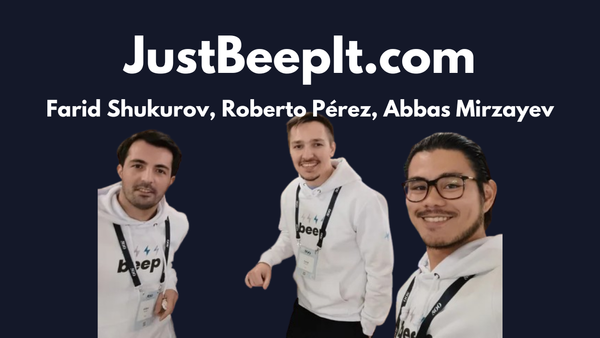How to turn a simple analytics app into a SaaS with $1M ARR - Pallyy ($85k MRR)

Hey! I'm Elias, all about startups and business vibes. Dreaming big of pulling off successful projects, so this year, I'm diving into the details of how they come to life and get managed. Gearing up to kickstart my own thing!
Before starting let me tell you that I UNDERSTAND YOU. I understand the fire you feel inside, eager to create a successful project. I also recognize the frustration that comes with not knowing what to create and how to do it. That's why I invite you to join me on this journey. Every week, I'll send you a newsletter featuring case studies about successful projects.
In each case study, I'll share with you the business story, addressing:
- How the founder/s came up with the idea.
- The challenges they faced.
- Strategies that made the project successful.
- Founders learnings: successes and mistakes.
- Ways you could replicate the idea.
The goal of this newsletter is to inspire you in creating successful projects.
So, let's begin with the first case study!
The first case study will be about Pallyy, a social media management platform for growing brands and agencies. It was founded by Tim Bennetto in 2019 as a solopreneur. By the time I am writing this Pally is making around $85k a month.
So let’s dive into how did Tim came up with the idea and built this SaaS:
Before starting Pallyy, Tim launched an app that he eventually sold for $10,000. The app was built by an external company. Even though it was a good experience, he realized that in order to build new apps he needed to learn to code.
In 2019, after some projects that went by without much fanfare. He decided to start ShareMyInsights (now Pallyy), an Instagram Analytics platform that gives you insights about your audience. The only point of difference with similar platforms was a feature that enables you to "share" your Instagram analytics with others.
Launching 🚀
The launch was a flop—Tim was all in on building the product but kinda skipped the whole marketing thing. But guess what? The first customers rolled in like a plot twist in a movie. Tim's friend used to run a free Instagram Analytics site but had to shut it down for some reason, so Tim asked him to redirect the traffic from his site to ShareMyInsights (now Pallyy), this ended up gaining Tim its first 100 customers (at $5/mo).
The valley of uncertainty 🏜️
In the next 2 years the growth was stalled around $1.3k MRR and the churn was high. He noticed two things:
- Nobody was using the “sharing” feature he built.
- The users wanted a feature to be able to schedule their posts.
So he removed the “sharing” feature and started to build the “scheduling” feature. With this two changes he managed to grow the MRR 100% (around $2,5k MRR) and to level out his churn rate.
Marketing Deep Dive: How Pallyy succeeded?
Once he found the Product-Market Fit, it was the moment to scale the project. The first move he did is a rebranding from “ShareMyInsights” to “Pallyy”. The new name was short, a cheap domain and fun but also not limited to a certain feature. The new logo cost him $1,500.
He also decided to focus on a niche of users: Social Media Agencies.
The next thing was to market Pallyy properly:

- He reached out to Social Media managers and Agencies via Instagram.
- He started running Ads on Instagram and Google but it didn’t workout for him (he needed a bigger budget).
- Hired a Blog writer and optimized SEO. (The turning point of Pallyy’s journey)
- He set an affiliate program.

On top of that he increased the subscription price $3.
The following year he had a 10x growth.
After 4 years as a solopreneur. Tim has decided to expand the team, he already hired a Senior Software Engineer, and he is planning to hire a customer support to handle the communications with the customers and a marketing role to help him take Pallyy to the next level.
With this story we can learn that anyone, and I mean anyone, can roll up their sleeves and build a successful SaaS. Tim’s journey started with a simple desire: to craft a better lifestyle. No degrees, no school diplomas, and absolutely zero know-how in coding or marketing when he kicked off. The secret? Just dive in and pick things up as you go. Embrace the journey, learn, and watch the magic unfold. It's a wild ride, but it's yours for the taking! 🚀
Learnings from Tim’s journey:
✅ Have a vision and be consistent. Even if sometimes things don't go as you want, stick to your plan.
✅ Learn to pivot the idea when needed. Understand your customers and track your product analytics.
✅ Focus on a niche of users to validate your product and then expand. Especially, if you’re launching a product in a crowded market.
❌$1,500 logo. If you are just in the beginning make sure you don’t waste too much money or effort in a logo or similar, you could use Canva (to do it yourself) or Fiverr (to externalize it).
❌Don’t forget to market your product. Even if you have the best product ever, if no one knows about it, you’re in big trouble.
❌ Bad branding “ShareYourInsights”. Choose a business name and brand that doesn't limit your growth, allowing for flexibility and creativity as your services evolve.
How could you replicate this idea step by step?
First things first, figure out how you're gonna stand out from Pallyy and other similar tools. Right now, two ways of doing it come to mind:
- Chat with potential users on LinkedIn or shoot them an email to find out what they wish these tools had. Also, check out the reviews on these tools to see what problems people are dealing with. When you're working on your MVP, aim to solve the issues that a bunch of customers are facing, not just the special ones that a couple of them have.
- Think about making a product like Pallyy but for a different niche. Just make sure you adapt the tool to this new subset of users.
Next thing:
- If you know how to code, choose your tech stack and start building your MVP. For instance, Pallyy uses mongoDB as a database, nodejs/express as the server and Vue/Nuxt on the front-end. Check this link if you want more information.
- If you don’t know how to code, you could either use NoCode or use pre-built code:
To build the MVP with NoCode you can try, for example, with Bubble.io:

- Start by signing up for an account and learning the platform through its tutorials.
- Create a database to store scheduling information, and design user interfaces for key functionalities like adding posts and setting up automation rules.
- Utilize Bubble.io's visual workflows to define the logic, integrating with social media platforms via API connections or built-in integrations.
- Implement automation rules to schedule and post content on social media, and include basic analytics to track metrics such as views and likes.
- Ensure a responsive design for various screen sizes and devices.
- Share the MVP with a small user group to collect feedback and iterate on the application, adding features and enhancing the user experience based on the received feedback.
- Finally, deploy the MVP to a live environment using Bubble.io's deployment options.
For this MVP you can also check other NoCode tools such as Zapier.com , Softr.io..
To build the MVP with pre-built code you can use some CodeCanyon scripts, click to check this one.
All done for today! I hope you learned and gained some insights from this case study. Catch you next week with another success story. Have an awesome week!!!





